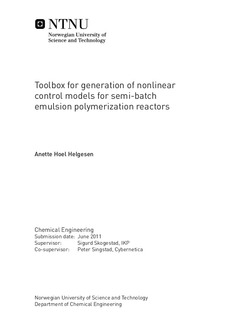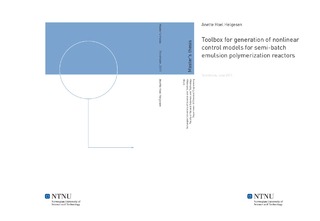| dc.description.abstract | The objective of this thesis was the study of emulsion polymerization and to model a complete, dynamic mathematical model of this process. Several variables that influence polymerization rate have been modeled with different methods to derive both simple and more complex models. As a result; several sub-models were collected in a library. All sub-models developed, constituted a toolbox for generation of nonlinear dynamic control models for semi-batch emulsion polymerization reactors. If nonlinear model predictive control technology is implemented in a plant, a nonlinear model is necessary. The use of model predictive control is beneficial. However, it is time-consuming and costly to develop mechanistic models suitable for use in NMPC applications. The model development time can therefore be decreased if a predefined modular library of configurable sub-models exist. An extensive literature search was performed, covering the emulsion polymerization process, control and modeling of this process and the challenges involved. Emulsion polymerization is a heterogeneous, multiphase, free radical polymerization process. The process is complex as nucleation, growth and stabilization of polymer particles are controlled by free radical polymerization mechanisms in combination with other colloidal phenomena. As a result emulsion polymerization was a challenge to model. The sub-models developed were implemented in MATLAB. All files were programmed as functions to make the implementation less complex. The library consists of the sub-model, intermediate calculations and other functions required to obtain the sub-models. The obtained sub-models predict monomer concentration in all phases, polymerization rate, overall monomer conversion, radical distribution, moles of particles, polymer chain structural characteristics (e.g. number- and weight average molecular weights), reactor temperature and pressure, jacket outlet temperature, and moles initiator that had not decomposed. Model simplifications and tools utilized for numerical integration of the model have been studied. The system was stiff and a variable-order solver for stiff systems was utilized in MATLAB (ODE15s). Calculation time was rapid for this solver. The model could be solved as an ODE system, independent of sub -models. As a result, a DAE system was not considered. Three different methods for calculation of monomer concentration in the polymer particles were derived; one comprehensive method and two simpler. The radical distribution could be found from a number of balances found on moles of particles, N(j) containing j radicals. These balances could be solved as multiple states, depending on how large j were defined. A new method for calculations of total moles of radicals was derived in this work. This method introduce less states in the model, as N(j) is not solves as states. For processes where the average particle number was lower than 0,5; a model simplification was found for such processes. The sub-models derived could be utilized to produce different product grades. This was possible to perform by altering the amount of chemicals, the use of chain transfer agent, inhibitor, etc., as all these were parameters in the model. The mole and energy balances were not difficult to alter, so that they could be utilized for different reactor configurations. If emulsion polymerization with several monomers were modeled, a more comprehensive change in all sub-models had to be consistent, as equations in this work were for mono-polymerization. The sub-models developed should be suitable for nonlinear model predictive control and the library with all the sub-models works as a solid basis for further development. All sub-models were tested on a case study; Semi-batch emulsion polymerization of poly-vinyl chloride. Various parameters had to be estimated; this became challenging as the model was too thorough compared to available measured values. The heat transfer coefficient was estimated with lsqcurvefit that is a part of the Optimization toolbox in MATLAB, and other parameters were estimated with trial-and-error. The predicted values for the outlet cooling jacket temperature and conversion were in acceptable agreement with measured values. The predicted pressure in Interval I and II had a reasonable match with the measured values in these intervals. Deviation occurred between predicted and measured pressure in interval III; there can be different explanations for this deviation. Predicted average number of radicals per particle was in the range found in literature, and the other predictions in the model were reasonable. The new method derived for the radical distribution gave the same predictions as solving N(j) as states, and the new method is recommended for modeling emulsion polymerization processes. The model was validated utilizing measured values from two batch processes, with different temperature profile and recipe. The predictions were acceptable for both batches. | nb_NO |

